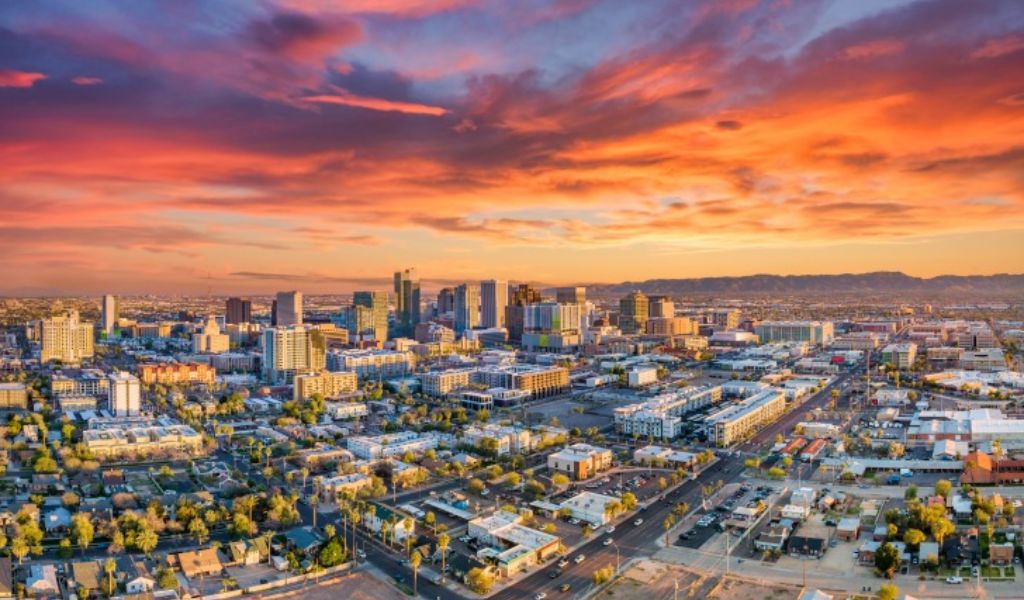Arizona is home to several magnificent natural wonders, including the famous Saguaro cactus, the Grand Canyon, and the red rocks of Sedona. But it also faces significant challenges from a high crime rate, especially in some cities. Arizona reported 484.8 violent crimes and 2,507.8 property crimes per 100,000 people in 2020, above the national norms of 379.4 and 2,109.9, respectively, according to FBI figures. Tolleson is the riskiest of Arizona’s ninety-one cities and municipalities. In this piece, we explore Tolleson’s reasoning for making this distinction as well as the problems and ramifications that follow.
Why Tolleson Is Arizona’s Most Dangerous City
Located west of Phoenix, Tolleson is a tiny Maricopa County community with 7,216 residents as of 2020. It is home to multiple Fortune 500 corporations, including PepsiCo, Kroger, and Sysco. Even with its thriving economy and close proximity to the state capital, Tolleson faces a serious crime problem. Areavibes data for 2020 showed that Tolleson had an astounding crime rate of 13,374 per 100,000 population, which was 470% higher than the national average. This corresponds to a 1 in 83 risk of suffering violent crime and a 1 in 8 chance of becoming a victim of any crime. Theft, burglary, and assault are the most common crimes; there are also occasional cases of robbery, rape, murder, and arson.
The following could explain why Tolleson is regarded as the most hazardous city in Arizona:
- Location and infrastructure: Tolleson is vulnerable to drug-related crime and violence, as well as the trafficking of stolen items and automobiles, due to its closeness to Interstate 10, a significant route for drug trafficking and smuggling from Mexico and California.
- The city also struggles with a lack of law enforcement resources; within its jurisdiction, there are just 15 sworn police and 11 civilian staff members.
- Economic and social conditions: Tolleson demonstrates a socioeconomic dichotomy, with a poverty rate of 18.9%, higher than the state average of 13.5%, and a median family income of $43,681, less than the $62,055 state average. These circumstances create a strong demand for narcotics and an ideal environment for criminal activity. In addition, Tolleson has a history of discriminating against people based on their race and ethnicity. Previously, it prohibited Native Americans and African Americans from living or working there.
- Influence on culture and politics: Tolleson faces challenges in forging a unique and constructive identity amidst nearby metropolises such as Phoenix, Glendale, and Avondale, despite its advantageous location. Low civic engagement exacerbates problems by making Tolleson more susceptible to crime, corruption, and disregard from the media and government, as demonstrated by the low 19.6% voter turnout.
What Does It Mean That Tolleson Is Arizona’s Most Dangerous City?
The fact that Tolleson has been named the most hazardous city in Arizona has significant ramifications for the citizens of the city, the county, and the state:
- Crisis in public health and safety: Crime and violence are serious dangers to the public health and safety of Tolleson, increasing the risk of injury, infection, trauma, and death, among other health risks. Given that Tolleson’s 2019 death rate of 1,029.8 per 100,000 people was higher than the state average, the town faces difficulties in delivering emergency services and healthcare to all citizens, especially those who are underfunded or uninsured.
- The burden of crime and justice: Tolleson’s criminal justice system bears a heavy cost and burden due to the high frequency of crime and violence, which necessitates significant resources from law enforcement, courts, prisons, and victims. The average annual cost of incarceration in Arizona is higher than the national average. In addition, problems are made worse by tense ties between the community and the police as well as problems with openness in the criminal justice system.
- Impact on society and economy: Crime and violence hinder Tolleson’s growth in these areas, negatively impacting people’s quality of life, the stability of their families, and the prosperity of the community. Tolleson’s growth and vitality are impeded by high unemployment rates, poor levels of educational attainment, and reduced economic prospects, which highlight the wider societal repercussions of crime.
What Are the Drawbacks of Tolleson Being Arizona’s Most Dangerous City?
Several obstacles arise from Tolleson’s ranking as the most violent city in Arizona:
- The precarious balance between deterrence, rehabilitation, restoration, and retribution is necessary for effectively handling crime and violence. This is known as the “prevention and intervention dilemma.” To effectively combat crime, Tolleson must put into practice comprehensive measures that include enforcement, education, treatment, and mediation, as well as develop partnerships with other governmental entities.
- Tolleson faces challenges in acquiring precise and up-to-date information regarding criminal activity, aggression, and the root causes of these issues. To determine the extent of the problem and the effectiveness of treatments, trustworthy data sources are critical. Even though Tolleson uses various data collection techniques, he still has problems with data comparability, accessibility, and quality.
- The difficulty of innovation and adaptation: Tolleson has to constantly adjust to the ways that criminal activity is changing, including organized crime, cybercrime, and drug misuse. Staying alert against new threats requires cross-sector collaborations and creative thinking to reduce risks and protect community welfare.
In summary
Tolleson’s ranking as the most hazardous city in Arizona highlights intricate socioeconomic problems and structural problems that call for a variety of approaches to be taken. To build a safer, more prosperous community for all citizens, Tolleson must address high crime rates while putting public health and safety first, improving community-police relations, and promoting economic possibilities. Coordinated efforts, creative solutions, and ongoing dedication from stakeholders at the local, county, and state levels are required to address Tolleson’s problems.

